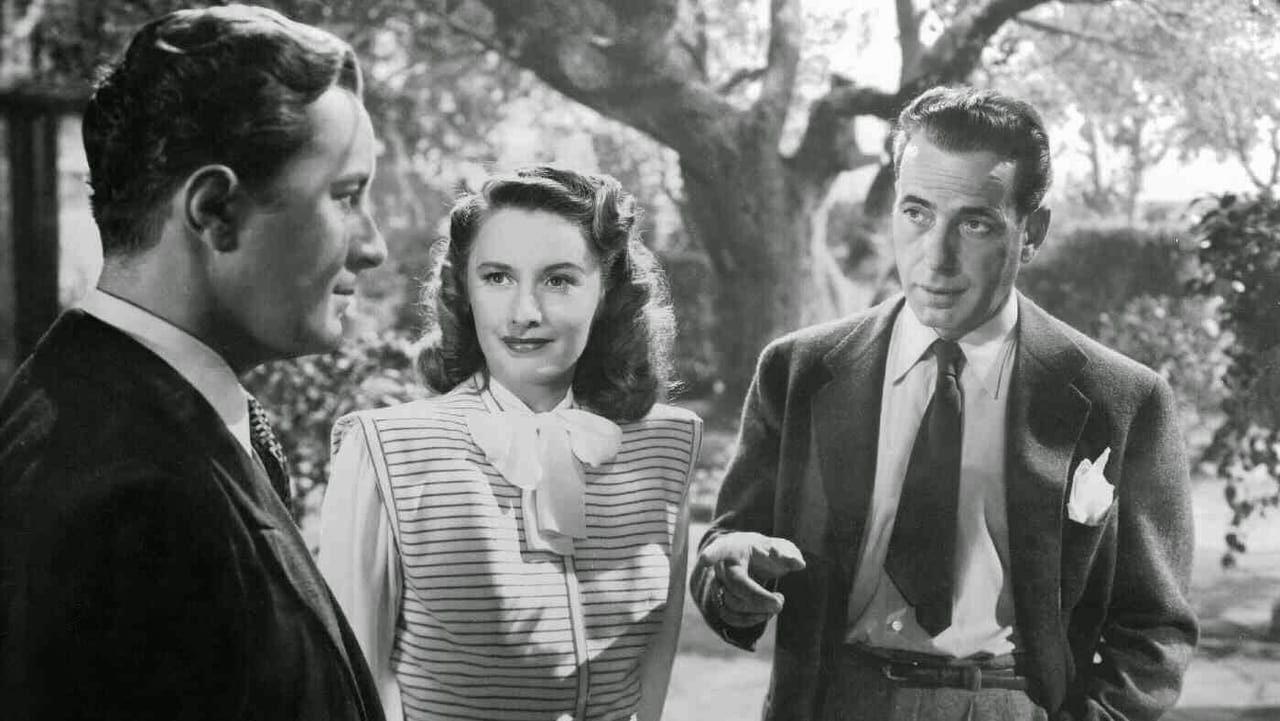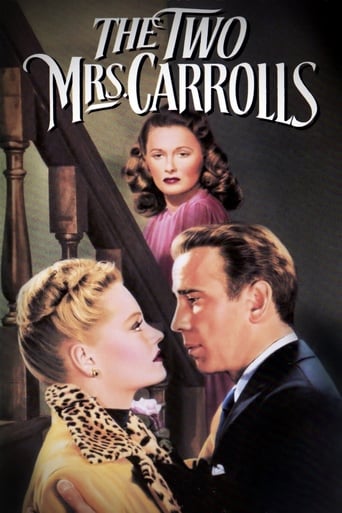

You could say that "Dragonwyck", "Secret Beyond the Door", and even Stanwyck's own "Sorry Wrong Number" all had elements of this film in them. Yes, I know Dragonwyck and Conflict were released before this film, but "Two Mrs Carrolls" was actually filmed in 1945 and just sat on the shelf at WB for two years.Stanwyck plays Sally Morton, a woman who has a whirlwind courtship with artist Geoffrey Carroll (Humphrey Bogart), until she finds a letter from Mrs. Carroll. Geoffrey then tells her that though he and his wife have been married ten years that his wife has been an invalid since the birth of their daughter. But Sally will have nothing to do with busting up a home.One great device of this film is that you never see the first Mrs. Carroll. You just see Bogey and the daughter coming in and out of her room. Geoffrey's mind turns to murder, and he is even painting his wife as "The Angel of Death". He signs for some dangerous chemicals at the pharmacist's and you see him going into his wife's room holding her milk, but looking like he is carrying a hand grenade.Next thing you know it is two years later plus some time, because it is mentioned that the first Mrs. Carroll has been dead that long. Sally is now married to Geoffrey, who is complaining that he can no longer paint, that he is mentally blocked. And then he meets the wealthy Cecily Latham (Alexis Smith) who wants her portrait painted. She shamelessly flirts with Geoffrey, stealing him right out from under Sally's clueless nose. Geoffrey wants to leave Sally for Cecily - and her money - plus that chemist he bought the poison from years ago? He's hanging around and blackmailing Geoffrey, who is hardly wealthy.The next thing you know, Sally isn't feeling too well, being told by her doctor to stay in bed. Then through casual conversation with Geoffrey's daughter - with whom she has a good relationship - some interesting facts about the first Mrs. Carroll come to light. When Sally convinces the daughter to let her into the locked room where Geoffrey is painting, what they find shocks them both.Although the idea of Bogart playing an artist seems silly at first, you don't see him that much as an artist - although Jack Warner wanted him to wear a beret and a smock which Bogart had the power by that time to veto. Stanwyck is great as a woman who finds out her dream marriage is a nightmare and Bogart's slide into insanity is artfully done. I do have to ask Cecily - and all homewreckers for that matter - if you can get him to leave his wife this time, won't it be all the easier for some other woman to do it down the line? The bloom won't stay on your rose forever! And now I turn to the daughter. She really is a necessary character. Her interaction with Bogart all through the movie and their good relationship brings out the humanity in Bogart's character, and she innocently relays information to Stanwyck's character that she could not have easily gotten any other way. The only weird part is how she seems to be eternally eight. She does not age over the three year period that this film takes place.In summary you have a great cast in a moody film set in a dark creepy English mansion. The housekeeper is a smart mouth from the word go, Nigel Bruce plays a doctor who is also a lush, and Patrick Moore as Stanwyck's old boyfriend has the patience of a saint. Unfortunately he has the sex appeal of one too. I'd recommend this one.
... View MoreViewed at 2013 Los Angeles Film Noir festival image1.jpeg The Two Mrs. Carrolls" (1947) features a most improbable Humphrey Bogart as a talented but mentally disturbed painter (if you can buy that -- who makes a practice of painting portraits of his wives, as the Angel of Death and then knocking them off — in England, no less. With Bogie delivering his lines in unadulterated "Casablancanese", even in this genteel English environment, it looks like he's playing in a different flick than the rest of the cast, but who cares, when the lady he wants to murder is Barabara Stanwyck, as the surviving Mrs. Carroll!Far from a classic, but one for the books as perhaps the least known of all Bogart flicks – and rightfully so. You'll never see it on TCM, but Humphrey does chew up the scenery when he starts freaking out (No one ever pulled one over on J. C. Dobbs). One of the extra delights of this film is the alluring A-list actress Alexis Smith, who tends to steal the show in the scenes where she appears and openly puts the make on Bogie in front of her high society mother and flustered wife Stanwyck. This one will make you loosen your critical straightjacket if you have it on. Redefines the classification "camp classic".
... View MoreThe Two Mrs. Carrolls is directed by Peter Godfrey and adapted to the screen by Thomas Job from the Martin Vale play. It stars Humphrey Bogart, Barbara Stanwyck, Alexis Smith, Nigel Bruce, Ann Carter and Patrick O'Moore. Music is by Franz Waxman and cinematography by Peverell Marley. Completed in 1945 but not released till 1947, The Two Mrs. Carrolls is one of those films that has an abundance of stories to match the abundance of divisive reviews. Various biographers and cinema writers tell a different story about stuff like what Bogart and Stanwyck thought of the movie, why they did it and so on. It's now hard to know exactly what the truth is anymore! So what about the film on its own terms then? Undeniably the critics of the time were right to point out the similarity of The Two Mrs. Carrolls to such fine movies of the time like Gaslight, Suspicion and Rebecca, in fact the delayed release is thought to be because of Gaslight's success in 1944, while there's even a slice of Dorian Gray about it as well. Having these massively popular films as benchmarks has kind of crippled "Carrolls" reputation, because quite frankly it's not close to being in the same league. However, if one can judge it on its own terms, this is very good Gothic thriller entertainment. Plot is essentially Sally Morton Carroll (Stanwyck) as a newly wedded wife who comes to realise her husband, Geoffrey (Bogart), is not the charming loving man she thought he was. He's the tortured artist type, who needs his muse to be kinked to produce his best work, thus the thriller conventions do proceed as Sally unearths dark truths and becomes a woman in peril. Various colourful characters are added to the mix; Smith's head turning sex bomb, Bruce's alcoholic doctor, Moore's lovelorn ex boyfriend and Carter's sprightly young daughter. The Carroll house is filled with many Gothic textures, marking it out as place ripe for dark deeds and the unfurling of sinister secrets. Godfrey, though guilty of letting the pace sag all too often, does insert some great mood accentuating scenes. Episodes with the fearsome paintings strike a chilly chord, a raging storm unloading as the curtains billow has the requisite haunting feel, and Geoffrey finally going over the edge produces a superb crash – bang – wallop scene. Marley's photography is suitably shadowy via lighting techniques, and Waxman provides a typically genre compliant musical score. On the acting front there's not a great deal to write home about, Stanwyck isn't stretched beyond being just professional, and as committed as Bogart is, he's an odd choice for this type of role. Bruce is typecast as another Dr. Watson character, while Smith is badly underused. The latter a shame as she leaves a favourable mark slinking about like a leopard, in fact it's probably no coincidence that she shows up late in the film wearing a leopard skin scarf! All told it's a little draggy in places and often shows its stage origins, but when it hits Gothic stride it's worthy of viewing investment. And yes, even if Bogart doing Bluebeard isn't the right fit. 7/10
... View MoreAlthough credits are top-draw, production values are very moderate. Peter Godfrey's direction is also a mite disappointing. Neither he nor screenplay writer Thomas Job have made much attempt to open up the stage play. Instant information dialogue is put across with a disconcerting lack of subtlety in both writing and delivery. Ann Carter's unrealistically precocious child and Nigel Bruce's blustering, stereotyped doctor are the worst offenders. Bogart himself delivers another of his very capable studies in psychopathology. Barbara Stanwyck is also cast strictly to type, but she too comes across effectively. Both she and Bogart give seemingly effortless portrayals as they both have parts they can play standing on their heads. Alexis Smith makes a strong impression in an unsympathetic part. On the other hand, Patrick O'Moore makes a wet, colorless hero. In the support cast, Anita Bolster (looking rather like Margaret Hamilton) gives an audience-pleasing portrait of a cynical servant. Godfrey himself does a brief and amusing cameo as a race-track con man. Barry Bernard registers as the blackmailing Blagdon, while Isobel Elsom delivers her usual capable rendition of a high society lady. Godfrey's direction is at its best in the climax with the camera tracking across the room with Bogart as he makes his preparations. It must be admitted that Godfrey sees the action from a cinematic rather than a stage audiences' point-of-view, but his approach is often unimaginatively routine. All the same, certain sequences do have power (the murder, the climax, the discovery of the portrait), but thanks as much to deft film editing and atmospheric photography by Peverell Marley (who lights Miss Stanwyck most attractively) as anything else. Stanwyck is also most attractively costumed and made up. Alert music scoring effectively mirrors every cue in the dialogue.
... View More